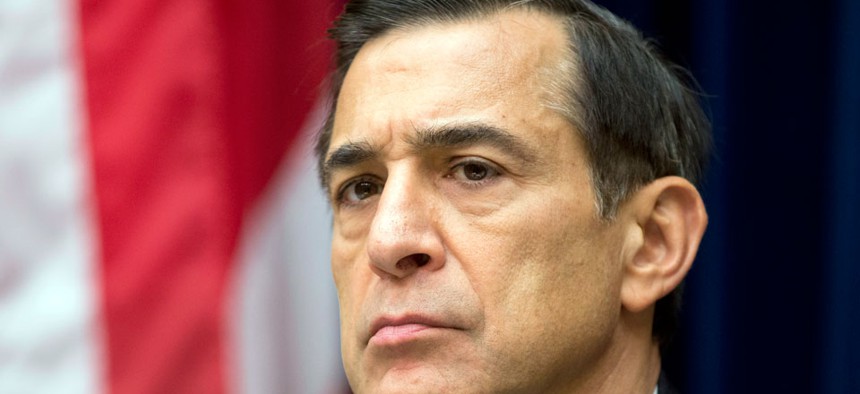
House Oversight and Government Reform Committee Chairman Rep. Darrell Issa, R-Calif. Manuel Balce Ceneta/AP
Are 'Pretty Buildings' Endangering Diplomats?
Oversight committee chairman says looks should not come at the expense of safety.
The Obama administration’s efforts to achieve visual excellence as well as security in embassy design came under fire Thursday by Republicans on the House oversight panel, who warned that construction of “fancy buildings” wastes money that could be used to better protect diplomats.
Two State Department officials argued that the new approach is within budget and that every overseas site presents unique challenges.
In a hearing that roped in threats over State Department “stonewalling of documents” and allusions to the four U.S. employees killed in the 2012 attack in Benghazi, Libya, Rep. Darrell Issa, R-Calif., chairman of the House Oversight and Government Reform Committee, mocked the State Department’s switch from the decades-old Standard Embassy Design approach to its Excellence in Diplomatic Facilities initiative. “These sweeping reforms that look better but cost more are causing continuing delays in construction and rising costs that are putting Americans overseas in danger,” said Issa. Repeating a quote from a diplomat saying embassies and consulates should not look “hostile” to the host country’s people, the chairman said, “I’m sorry to say this but were our diplomats in Benghazi murdered because the building felt hostile?”
He called it “contemptible” that State has not delivered the documents he requested in a June 26 letter to Secretary of State John Kerry dealing with construction contracts and costs in dozens of overseas posts, including the new $1 billion compound in downtown London. “You are not the messenger who will be shot,” Issa admonished two witnesses from State’s embassy building office. “But you will be back again and again as more documents arrive.”
Co-panelist Rep. Jason Chaffetz, R-Utah, derided the attitude that “fancy buildings equals successful diplomacy. No one asks if these buildings should project innovation, humility and openness,” he said, adding that State’s embassy building budget rose from $17 billion in 2008 to $27 billion in 2014. He also blasted State’s failure to deliver documents, noting the one report requested was available for downloading on the website of the al Jazeera TV network.
Ranking member Elijah Cummings, D-Md., agreed on a need for State to provide the documents on embassy construction spending. But he noted that the London embassy is budget–neutral because State financed it by selling existing U.S. properties (a practice Issa questioned), adding that the U.S. embassy in Iraq built under the George W. Bush administration was famously over budget and plagued by delays.
Lydia Muniz, director of State’s Bureau of Overseas Buildings Operations since 2009, said the lessons from recent years show that U.S. outposts -- which number 275 in 190 countries -- can reflect “not only safety and security but durability, efficiency, flexibility, proximity for personnel and visitors, and a platform that serves the needs and mission of Americans abroad.”
Embassies and consulates vary widely, with staff ranging from three to 2,500 and windows from one to 100, she said. “We take into account the local conditions and materials and long-term costs,” she noted. “For many it’s the only America most overseas will ever see.” Planners must also consider that land is expensive, and long commutes to suburban facilities threaten diplomats’ safety.
The excellence program operates within the normal annual appropriation and so far many projects are spending marginally less than planned, said both Muniz and her deputy, Casey Jones. “We have a depth and breadth of data,” said Jones. But “obviously OBO cannot anticipate every potential impact. Real world events affect our projects just as much as they do others in the design and construction industry. Our projects are not immune to unforeseen cost increases in construction materials or shortages, contractor performance, fuel shortages, disruption due to civil unrest, currency fluctuations, weather events and natural disasters.”
Issa challenged their assertions that money is being saved, showing slides of the elaborate U.S. embassy in Mozambique and comparing it with the more plain one in Burkina Faso. “For $200 million with materials from Europe, you could have built 20 other embassies,” Issa said.
The Republicans’ case drew support from Grant Green Jr., the former undersecretary for management under Secretary of State Colin Powell who recently chaired the post-Benghazi committee on embassy security organization and management. Talks with “experts and State’s Diplomatic Security staff revealed concerns about certain aspects of the Excellence approach,” he said. “We didn’t recommend throwing out the baby with the bathwater or doing away with this crazy scheme, but that State take an in-depth look at security.” Green said adapting facades for the host country to make it look pretty is “not in my opinion the priority, which has to be security. The idea that it costs less is just not logical to people I’ve talked to or to me.”
On the status of the demanded documents, Muniz said, “We take the committee’s request seriously, but the request is a vast one, and we’re working as quickly as possible."







